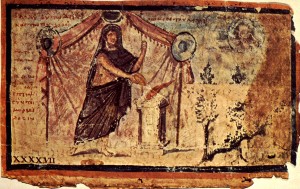
– Dr. Jaime G. Corvalan, MD, FACS
We have discussed elsewhere what consciousness is; this post discusses our role in the process of the unfolding of consciousness.
As consciousness exists outside of the realm of duality (time and space, our perceived reality), we cannot say that we participate in the creation of consciousness. Rather, the basic function of humanity is unfolding, modulating, manifesting and structuring consciousness.
You can think of consciousness like radio signals being transmitted into the environment; they’re everywhere but, if you don’t have the equipment to tune into them, to us they’re nowhere. We are the radio that tunes into the signal, bringing into objective existence that which would otherwise go unnoticed.
The eminent psychologist Dr. Carl Jung noted that whatever we deem to be the source of creation – the divine, the transcendent, god, etc – is all knowing yet, at the same time, is unconscious of its creation. This, then, gets to the heart of the basic function of humanity: only through humanity’s consciousness can the divine become aware of its creation.
Transcendent energy consciousness gives form and function to everything we perceive in this existence, but it is the role of humanity to bring into objective reality this creation by our participation in and observation of it. We bring a little light into what otherwise would be the world of mere, unconscious existence.
Now, the “basic function of humanity” is a very intellectual concept. We, as a species, didn’t sit down at a table one day and type up a mission statement for humanity. Rather, our purpose and meaning is expressed to us in the collective myths by which we live.
Myths, it might be said, have one foot in this world and one foot in the transcendent; that is, they are deep, archetypal symbols and images that speak to us not in words but in images, dreams and stories, and go back deep into the collective unconscious of all life. Dr. Jung has noted that humanity presently faces a “Crisis of Mythlessness.”
The old myths in the Western world (expressed in Christianity) no longer hold sway and cannot provide us with the cultural cohesion they once did – and which we need in order to channel our creative impulses and restrain our destructive ones. Dr. Jung has observed that we are in the midst of the creation of a new myth for humanity, one which gives purpose and meaning for humanity going forward.
In this new, cohesive myth, humanity and the divine compliment and affect each other, making us in effect co-creators of existence through our consciousness of it. How this occurs is the subject of the post “How Does Humanity Structure Consciousness?”
